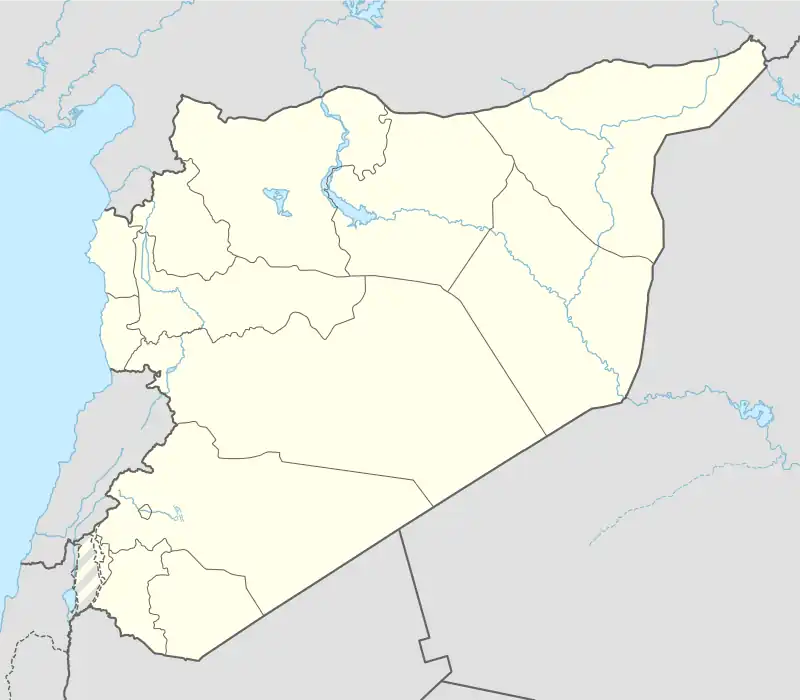Qasr al-Hayr al-Sharqi
Qasr al-Hayr al-Sharqi (Arabic: قصر الحير الشرقي, lit. 'Eastern al-Hayr Palace or the "Eastern Castle"') is a castle (qasr) in the middle of the Syrian Desert. It was built by the Umayyad caliph Hisham ibn Abd al-Malik in 728-29 CE in an area rich in desert fauna.[1] It was apparently used as a military and hunting outpost.[2] The palace is the counterpart of Qasr al-Hayr al-Gharbi, a nearby castle palace built one year earlier.[1] It is one of the so-called desert castles.
| Qasr al-Hayr al-Sharqi قصر الحير الشرقي | |
|---|---|
 Panoramic view of Qasr al-Hayr al-Sharqi | |
 Location within Syria | |
| General information | |
| Town or city | Homs Governorate |
| Country | Syria |
| Coordinates | 35.073889°N 39.071111°E |
| Technical details | |
| Material | adobe |
Location
Qasr al-Hayr al-Sharq is 28 kilometres (17 mi) from Al-Sukhnah and 100 kilometres (62 mi) from Sergiopolis (Rusafa), near Bishri Mountain near Palmyran Middle Mountains.
Syrian Civil War
During Syria Civil War, Qasr al-Hayr al-Sharqi was captured by armed groups in 2013, then by ISIS. The Castle have been damaged by looting and vandalism. The visitor house has been burgled.[3] The Syrian Army recaptured the castle on 22 August 2017.[4]
Architecture
Like other Umayyad architectural works, the construction style was influenced by Byzantine and Sasanian architectures.[5]
The palace consists of a large open courtyard surrounded by thick bulwarks and towers guarding the entrances as well as each corner.[6] The palace consists of two square structures, one with a diameter of 300m and the other of 100 metres (330 ft). The palace(s) contains remnants of rooms, arches and columns which seem to be parts of a huge royal complex. Some of the decorated parts have been moved to the National Museum of Damascus while the gate has been reconstructed in the Deir ez-Zor Museum.[7]
The bigger palace has been several floors, with a huge gate and many towers. Towers were not built as defensive measures. There were also olive yards. The palaces were supplied with water by nearby Byzantine church by a canal 5,700 metres (6,200 yd) long. The palaces contained bathrooms, water reservoirs, mosques and gardens.
World Heritage Status
This site was added to the UNESCO World Heritage Tentative List on June 8, 1999, in the Cultural category.[8]
Gallery
 Walls and towers
Walls and towers Walls and towers
Walls and towers Byzantine arches and columns
Byzantine arches and columns
See also
Notes
- Constable, O.R. (2003). Housing the Stranger in the Mediterranean World: Lodging, Trade, and Travel in Late Antiquity and the Middle Ages. Cambridge: Cambridge University Press. p. 56. ISBN 0-521-81918-0.
- Un Château du désert: Qasr al-Hayr ach-Charqi - UNESCO World Heritage Centre Archived February 13, 2009, at the Wayback Machine.
- A desert Castle: Qasr al-Hayr ach-Charqi (UNESCO)
- @watanisy (22 August 2017). "tigers captured Qasr al-Hayr al-Sharqi" (Tweet) – via Twitter.
- Arce, Ignacio. "UMAYYAD BUILDING TECHNIQUES AND THE MERGING OF ROMAN-BYZANTINE AND PARTHO-SASSANIAN TRADITIONS: CONTINUITY AND CHANGE". Late Antique Archaeology. Retrieved 4 April 2019.
- Un Château du désert : Qasr al-Hayr ach-Charqi - UNESCO World Heritage Centre Archived February 13, 2009, at the Wayback Machine
- Bonatz, Dominik; Kühne, Hartmut; Mahmoud, As'ad (1998). Rivers and steppes. Cultural heritage and environment of the Syrian Jezireh. Catalogue to the Museum of Deir ez-Zor. Damascus: Ministry of Culture. OCLC 638775287.
- "Un Château du désert: Qasr al-Hayr ach-Charqi - UNESCO World Heritage Centre". Archived from the original on 13 February 2009. Retrieved 4 March 2009.

